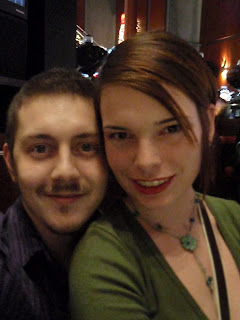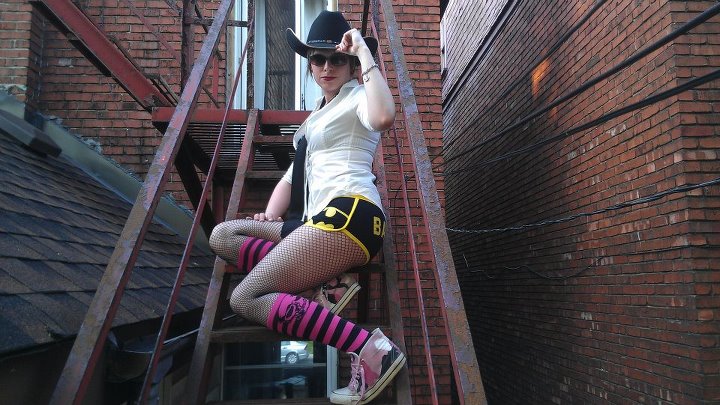I first heard about Project Priceless when Jordan attended Social Capital this summer… She was a month from her wedding day - a wedding mostly funded through donations, barter and DIY!
One of my favourite parts of their story is that Jordan and Brian were able to do what I love most about social media - bring online community into the real world. They had people they had never met before starting this project at their wedding LIVE TWEETING it. I love that so much!
I asked Jordan if she would answer some questions about Project Priceless for the blog because I found the project so fascinating. I think what made it so successful was not simply that they were willing to give publicity to the businesses who were helping them out but that Jordan and Brian are so authentic in the way they portray themselves online (which is authentically fun, quirky and lovable) that people genuinely like them and want to be a part of what they’re doing.
People scrambled to be a part of their story and having recently gotten to meet them in person and have a chance to really start to get to know them, I’m not surprised at all!
Tell us your story
Brian and I got engaged in October 2010. We’d faced some major life events, including some layoffs, so we knew we wouldn’t be a in place to put together a wedding.
The original concept for Project: Priceless was simple: get some former brides and grooms to help us out by offering up their wedding decorations and other leftovers. We started a blog, figuring that family and friends would help out and would be curious to see what we crafted together. It was only a few weeks, though, before the community came a-knockin’: both strangers and businesses heard about us through the press, social media, and word of mouth. Once that started, it only made sense to start offering a trade: anecdotal blog entries about our participants, in exchange for goods and services. The individuals without businesses just enjoyed being mentioned, and the commercial participants found that P:P had enough clout to drive traffic their way.
Within two weeks, we had 1,000 hits on our blog; in the first two months we had 9,000 hits. By the end of the project, we had over 70,000 hits, and over 150 offers of items and services.
 Wedding tattoos. credit: lauraelizabethfoto.wordpress.com
Wedding tattoos. credit: lauraelizabethfoto.wordpress.com
What social media channels were most successful for you and how. Was Twitter the primary source?
We actually didn’t really get going on Twitter for the first couple months of the project. We’d see traffic coming off twitter, but we just didn’t understand the appeal of the thing. I started a twitter account just to be able to keep track of who was tweeting about us, but it wasn’t long before I fell in love with the simple communication of it. Looking back, I wish we’d jumped on the tweet wagon earlier.
The blog grew through twitter and facebook primarily, and through a lot of networked individuals. Most people who participated in the project had heard about us through someone they network with (fellow crafters, work colleagues, classmates, etc). We got a ton of people through good ol’ word-of-mouth, but most people who started talking about us had read about us online somewhere.
What did you learn from the experiment? (I love her answers - I want to turn some of them into blog posts they are so fabulous. :))
Well, first off we learned a lot about social media and how it works for marketing. There’s a big mental shift that has to happen when you’re looking to take your social media practice from playtime to work time. I’ve spent over ten years thinking up cheap and innovative ways to market causes and campaigns for the non-profit sector; social media was an organic progression for someone who’s used to having no budget and only time to invest.
We learned some inalienable truths:
-Rookies are often more fun and flexible…while also making more ‘rookie’ mistakes, obviously.
-There’s a ratio of worry-to-money-to-time when planning a major event: where you save on one, you pay with more of the other two.
-The instant and ‘real time’ nature of social media means that networking is intense, constant, and sometimes not well-worded; a thick skin and a quick apology are must-have tools.
-Social media has made tighter social and network circles. People are in constant contact, building more intimate relationships with colleagues. This is a blessing and a curse. It’s a little bit like taking each group of industry professionals and sticking them in the house on Big Brother: there’s drama, intrigue, and a real need for diplomacy.
-Unlike traditional media, which is usually seen as a bit of a monster, social media is viewed as the ‘feel good’ form of marketing. This made it a very good fit for our project, which was all about feeling good, doing good, and creating something fun.
-What you save in money when you employ social media, you will pay for with time.
-No matter what you do, or how careful you word things, there will always be an internet troll out there. He may have minions. They may all hate you. They are a natural part of the circle of new media.
-Spend time seeking out and interacting with people who do something better than you do. Follow good news-spreaders, trend-namers, and Kevin Bacons: people who are connected with everyone.
We also learned that we love love love doing this. When the wedding ended, fans begged us to continue, and we obliged. We’ve loved adhering to the principles of DIY, COMMUNITY, and ECO-ECONOMY, so we decided we’d spend time blogging a new Project: Priceless blog—the Nest—all about our newlywed journey. We’re cooking food, upcycling furniture, taking classes, and interacting with indie businesses, in a much larger and flexible format than the wedding project could offer. It’s exciting and should make for some great reading.
 Adam Pap photograpy: photosbyadampap.com
Adam Pap photograpy: photosbyadampap.com
Do you think this is something people could continue doing or would the novelty wear off?
We get this question a lot. The truth is, we never intended to build a model for others to follow precisely. We just knew we wanted our wedding to be something really different…for it to reflect our sense of adventure, and for it to be a full-out project.
It would be difficult to emulate our project exactly; there have been other weddings in the past that utilized one aspect or another that we used, but none we found that incorporated very facet as we did: social media channels, promo for trade, DIY work, barter, eco-economy, and budget-friendly…not to mention, a new concept we’ve been calling ‘community symbiosis’: indie business supporting people who support indie business.
We’ve got tons of advice to share with other would-be brides and grooms, though, and we suggest that couples choose specific aspects of our project to try for themselves. The main concepts are DIY, COMMUNITY, and ECO-ECONOMY: every couple can implement some aspect of these themes.

Visit Jordan and Brian at their new blog where I am certain we’re going to see many more exciting things from them!





